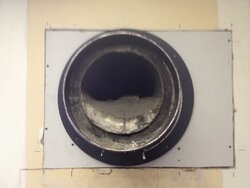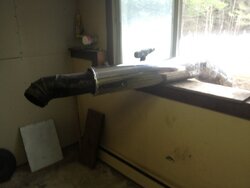I have a short section of horizontal pipe left in my run to the vertical chimney outside. This is not avoidable because it goes through the thimble in the wall here. I recently took my pipe apart and cleaned it all out because it has been a while and I have been burning a lot of wood with the cold weather. This is why I don't liked the idea of horizontal pipe. I forgot the after cleaning picture. LOL
The results of horizontal pipe with Wood Gun.
- Thread starter Gasifier
- Start date
-
Active since 1995, Hearth.com is THE place on the internet for free information and advice about wood stoves, pellet stoves and other energy saving equipment.
We strive to provide opinions, articles, discussions and history related to Hearth Products and in a more general sense, energy issues.
We promote the EFFICIENT, RESPONSIBLE, CLEAN and SAFE use of all fuels, whether renewable or fossil.
You are using an out of date browser. It may not display this or other websites correctly.
You should upgrade or use an alternative browser.
You should upgrade or use an alternative browser.
- Status
- Not open for further replies.
BoilerMan
Minister of Fire
How many cord you put through with that much buildup Gass?
TS
Hmmmm. Now I have to remember when I cleaned it last. Estimate. About two cord.
Ncountry
Feeling the Heat
This is true. The only place I seem to get some creosote now is at the cap of the chimney. Going over to insulated pipe inside as well has helped.On the plus side, it looks like all fly ash and no creosote.
muncybob
Minister of Fire
My long inclined horizontal run is also unavoidable. I got about 2 cups of fly ash when I last cleaned it after 2 months of burning(Dec-Jan). A considerable amount more does collect in the 90 elbow at the bottom of my chimney though, which requires an every other month cleaning to avoid blocking the chimney. I didn't realize this the 1st year of wood usage and when I pulled the horizontal pipe at the end of the season that elbow was about 75% blocked!
stee6043
Minister of Fire
Eeekkk...I'd personally be learly of posting such photos on the interweb. I believe most of our UL 103 HT pipes have a requirement of having not more than 24" horizontal to be a "manufacturer approved installation". Is that entire section horizontal?
Should you ever suffer an insured loss your underwriters may well find things like this and use it to fight a payout...
My two cents only.
Should you ever suffer an insured loss your underwriters may well find things like this and use it to fight a payout...
My two cents only.
My long inclined horizontal run is also unavoidable. I got about 2 cups of fly ash when I last cleaned it after 2 months of burning(Dec-Jan). A considerable amount more does collect in the 90 elbow at the bottom of my chimney though, which requires an every other month cleaning to avoid blocking the chimney. I didn't realize this the 1st year of wood usage and when I pulled the horizontal pipe at the end of the season that elbow was about 75% blocked!
As long as the cyclone does not get plugged, I don't usually see much at all in there. I had a pretty good amount of Ash at my 90 clean-out on the outside of the house as well. I pulled that plug after I had placed a box under it, then pushed this stuff through. I had more than 2 cups, probably more like 10! I would think most of that ash is from when I had a plugged cyclone during that time. Every once and a while that still happens. I check it much more often than I use to though. It had been a longer time this time since I had cleaned it and we had some pretty cold weather there a few times. I want to say it had been maybe 2 months and I had burned around 2 cord.
Eeekkk...I'd personally be learly of posting such photos on the interweb. I believe most of our UL 103 HT pipes have a requirement of having not more than 24" horizontal to be a "manufacturer approved installation". Is that entire section horizontal? Should you ever suffer an insured loss your underwriters may well find things like this and use it to fight a payout... My two cents only.
Safety is the reason I did away with all horizontal that was not absolutely necessary. This is the only section of horizontal I have and it is, you guessed it, a two foot section.
 Now, why would they have that requirement with insulated and fire rated pipe. Safety I would think. And then AHS tells you to have longer sections of regular black stove pipe running horizontal with clean outs so you can clean them regularly.? I would think that would be more dangerous than what I have. Here is a shot of it when it is in place.
Now, why would they have that requirement with insulated and fire rated pipe. Safety I would think. And then AHS tells you to have longer sections of regular black stove pipe running horizontal with clean outs so you can clean them regularly.? I would think that would be more dangerous than what I have. Here is a shot of it when it is in place.muncybob
Minister of Fire
I believe at the old AHS "showroom" location they had a running WG with about a 4' horizontal run.
Gas, it seems you check the cyclone frequently...does it not need to be re-caulked after each inspection?
Gas, it seems you check the cyclone frequently...does it not need to be re-caulked after each inspection?
The only place I recaulk is right above the cyclone where the black pipe comes out of cyclone. Just the connection at the cyclone. I then seperate where you see the horizontal start and it all comes out in one piece. Then I have the joints of the insulated pipe sealed with a high temp tape to stop any air leakage. I need to buy a higher temp tape though.
mark123
Member
I have almost 9' of horizontal pipe and I usually clean it once a year. I was under the impression that AHS recommended long horizontal runs to minimize the risk of glowing embers escaping out the chimney, in my situation it was the only way. I recently built all new pipe from 16 gauge stainless, all Tig welded with bolted on flange covers for cleaning. I got fed up with smoke escaping from seams and had an episode of the silicone burning off with flames almost touching the wooden floor joists (wife witnessed it). Materials cost me around $250.00 plus my welding time. Completely air tight now.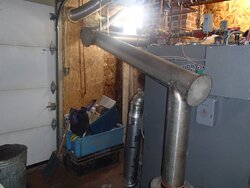
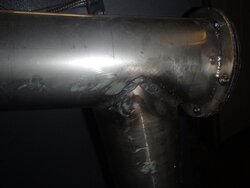


avc8130
Minister of Fire
mark123
Member
It fits inside the cyclone and 3 self tapping SS screws hold it there, I had to seal it there with high temp silicone. My silicone burning problem occured in the horizontal run of my previous pipe, small charcoal bits accumulated there and then caught on fire, the whole first run was glowing bright orange and the silicone burned off. This should not happen at the cyclone and if it did there is nothing there to catch fire.
avc8130
Minister of Fire
If/when my double-wall needs replacement I plan to do similar.
How did you interface with the masonry chimney?
ac
How did you interface with the masonry chimney?
ac
Mark123. That is a nice set up you have there. Nice work man. So what you are saying about AHS's idea is the live embers will drop before getting to chimney with the horizontal runs. Then you clean them out. The only problem with this thinking is if you get someone who has the regular black pipe and has it all sealed up with high temp caulk they hate to break that nice seal of caulk more often than they should. It gets to be a pain. Then on occasion their ash cyclone gets plugged at the bottom and before they find out some more ash and charcoal has been deposited in the pipes. Repeat this a couple/three/four times and before you know it you have a potential for a full blown fire in a pipe that is not designed to handle that fire. Many of those high temps caulks are also not designed for a fire that may be above those temps. With your set up only costing you about 250 plus some welding time, it would seem to cut the risk by an great bit. I went over to insulated S.S. chimney. I hope some day to have a welder weld the seams of my pipe together if he can weld that thin wall pipe. ?
mark123
Member
I have 7" ss liner which comes out of the brick chimney approx 12" , the 6" pipe I made fits inside this and I wrapped several wraps of 3/4" fiberglass rope (woodstove door seal) around the 6" and stuffed it into the space between the 2, just before the last wrap I squeezed high temp silicone in there as well and then put a final wrap of rope and stuffed it all in. 3 wraps of rope then silicone then another wrap.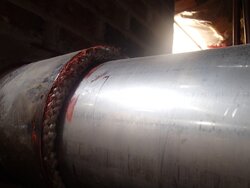

Mark123. I probably asked you this before and forgot. My brain works sometimes. Sometimes not. How much do you heat with that massive machine of yours?
mark123
Member
To make the pipe I just had a local sheet metal shop roll me some 16 gauge 304SS, I then put some ratchet straps around it to bring it tight and then Tig welded it. Those flanges come off in a few seconds using a cordless drill to remove the 1/4" SS machine screws. For the seal I put high temp silicone on one flange and then bedded some 1/2" door seal rope in it. I then waxed the cover with paste wax and loosely fitted screwed it on until the silicone set for a day. Now it can be removed and replaced easily and when tightend is air tight. Cutting the fishmouth shaped ends of the pipe on an angle was tricky and took some trial and error.
avc8130
Minister of Fire
Mark123. That is a nice set up you have there. Nice work man. So what you are saying about AHS's idea is the live embers will drop before getting to chimney with the horizontal runs. Then you clean them out. The only problem with this thinking is if you get someone who has the regular black pipe and has it all sealed up with high temp caulk they hate to break that nice seal of caulk more often than they should. It gets to be a pain. Then on occasion their ash cyclone gets plugged at the bottom and before they find out some more ash and charcoal has been deposited in the pipes. Repeat this a couple/three/four times and before you know it you have a potential for a full blown fire in a pipe that is not designed to handle that fire. Many of those high temps caulks are also not designed for a fire that may be above those temps. With your set up only costing you about 250 plus some welding time, it would seem to cut the risk by an great bit. I went over to insulated S.S. chimney. I hope some day to have a welder weld the seams of my pipe together if he can weld that thin wall pipe. ?
Gas,
If you REALLY follow AHS's suggestion it makes perfect sense. AHS suggests horizontal runs to trap any fly ash and embers that get pushed through the cyclone. They ALSO recommend you use clean-out tees instead of elbows. This allows access to clean the horizontal run about as easily as you can access the gassification tubes.
I took a tip from Dean at Smokeless Heat. Rather than use high temp silicone on the clean out cap, I stuff Roxul around the cap and screw it in. Works perfect and is super easy to service.
No flying embers out my chimney, easy maintenance.
ac
mark123
Member
I heat 4000SF and run it in the summer for domestic as well. I probably could have gotten away with a 140 but I wanted to make sure I had enough. Also I might put a hot tub out on the deck someday and would like to hook it up to the woodgun as well
Gas,
If you REALLY follow AHS's suggestion it makes perfect sense. AHS suggests horizontal runs to trap any fly ash and embers that get pushed through the cyclone. They ALSO recommend you use clean-out tees instead of elbows. This allows access to clean the horizontal run about as easily as you can access the gassification tubes.
I took a tip from Dean at Smokeless Heat. Rather than use high temp silicone on the clean out cap, I stuff Roxul around the cap and screw it in. Works perfect and is super easy to service.
No flying embers out my chimney, easy maintenance.
ac
Ja. I know, and knew what they were trying to do with their runs. I also know that mine works better for my situation. It is safer. Period. And I have only one joint I have to caulk now. Better, in my opinion.
avc8130
Minister of Fire
mark123
Member
I have approx. 20' of 6" ductwork for the intake, I was told to go down right out of the boiler so if the fire started burn backwards do to a malfunction such as the fan shuting off and the air inlet door staying open that the smoke would not be drawn out, The main reason I did the cold air intake was to eliminate smoke entering the house when it starts chugging , one time I had one of those explosions and it blew the long section of ductwork wide open. All the seams are duct taped now. Even with everything sealed as best I can I still get a tiny creosote smell throughout the house the odd time and I can't figure out where it is coming from, it must be coming from somewhere after it shuts down and is idle. All door seals are good and tight and air inlet flap seal is good
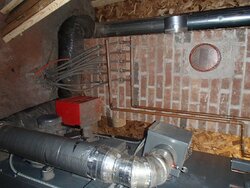

stee6043
Minister of Fire
It looks like your homemade smoke pipe gets pretty close to that plywood. Any concerns there, Mark?
I've never heard of someone making their own vent pipe. It looks awesome but I can't help but wonder what the code/insurance guys would think...
I've never heard of someone making their own vent pipe. It looks awesome but I can't help but wonder what the code/insurance guys would think...
- Status
- Not open for further replies.
Similar threads
- Replies
- 14
- Views
- 610
- Replies
- 0
- Views
- 1K
- Replies
- 0
- Views
- 182
- Replies
- 13
- Views
- 804


